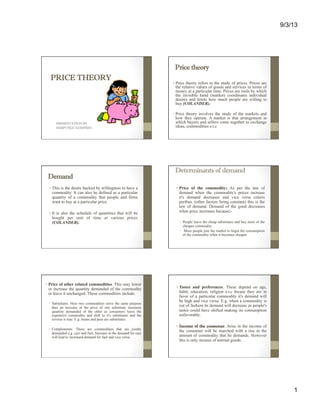
Price theory
- 1. 9/3/13 PRICE THEORY PRESENTATION BY SEMPUNGU GODFREY Demand • This is the desire backed by willingness to have a commodity. It can also be defined as a particular quantity of a commodity that people and firms want to buy at a particular price. • It is also the schedule of quantities that will be bought per unit of time at various prices (COLANDER). • Price of other related commodities. This may lower or increase the quantity demanded of the commodity or leave it unchanged. These commodities include. • Substitutes. Here two commodities serve the same purpose thus an increase in the price of one substitute increases quantity demanded of the other as consumers leave the expensive commodity and shift to it's substitutes and the reverse is true. E.g. beans and peas are substitutes. • Complements. These are commodities that are jointly demanded e.g. cars and fuel. Increase in the demand for cars will lead to increased demand for fuel and vice versa. Price theory • Price theory refers to the study of prices. Prices are the relative values of goods and services in terms of money at a particular time. Prices are tools by which the invisible hand (market) coordinates individual desires and limits how much people are willing to buy (COLANDER). • Price theory involves the study of the markets and how they operate. A market is that arrangement in which buyers and sellers come together to exchange ideas, commodities e.t.c Determinants of demand • Price of the commodity; As per the law of demand when the commodity's prices increase it's demand decreases and vice versa ceteris peribus. (other factors being constant) this is the law of demand. Demand of the good decreases when price increases because;• People leave the cheap substitutes and buy more of the cheaper commodity. • More people join the market to begin the consumption of the commodity when it becomes cheaper. • Tastes and preferences. These depend on age, habit, education, religion e.t.c Incase they are in favor of a particular commodity it's demand will be high and vice versa. E.g. when a commodity is out of fashion its demand will decrease as people's tastes could have shifted making its consumption unfavorable. • Income of the consumer. Arise in the income of the consumer will be marched with a rise in the amount of commodity that he demands. However this is only incases of normal goods. 1
- 2. 9/3/13 Normal goods Income necessities • For the case of inferior when the income increases quantity demanded decrease as the consumer now sees the goods as of a lower status. E.g. some one shifting from local brew to beer as his income rises. • For necessities as the income of the consumer increases quantity demanded remains constant. E.g. demand for salt can not increase even if the income of the consumer was to increase. inferior Quantity • Population. The higher the population the higher the demand and vice versa. • Age. The more the population is composed of a mature and working population the higher the demand and vice versa. I.e. if the population is such that there are many young people and the very old in society demand will be low as they have low purchasing power. • For the case of normal goods increase in the consumers income is marched with an increase in quantity demanded. • Social and cultural factors. This considers people's beliefs and religion. In some societies the demand for particular goods is very low because of the culture norms e.g. pork in Saudi Arabia. • Price expectations (speculation). Incase people predict an increase in the prices in future due to random events such as war, they may demand more at the present to store for that future date thus increasing quantity demanded and vise versa. DEMAND FUNCTION • Seasonality. Some commodities are highly demanded during particular seasons and their demand falls when the season elapses e.g. demand of Christmas cards is high during the Christmas season and very low when the season elapses. • Qdx = Q ( Px, Py, Y, T, Pe, S, A,..) • Where Qdx is quantity demanded of commodity x. • Px is the price of commodity x. • Py is the price of other related commodities. • Y is the income of the consumer. • T is the tastes and preferences. • Pe is the price expectations. • S are the social factors e.g. culture and religion. • A is the age of the society. 2
- 3. 9/3/13 • The demand function shows that how much of a good some one wants to buy depends on many other things besides it's price. I.e. Individuals tastes and preferences, prices of other goods e.t.c. These are some of the factors held constant when making study of change in price on the goods quantity demanded (COLANDER). 3
